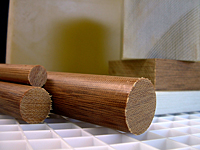NEMA CE - Canvas Phenolic Rod - Natural (Ground from Sheet)
Thermoset Composite
FED. SPEC. LP-509A TYPE II/CE / MIL-P-15035FBE / MIL-I-24768/14 TYPE FBG.
Industrial Phenolic Laminates are made by applying heat and pressure to layers of paper, canvas, linen or glass cloth impregnated with synthetic themosetting resins. When heat and pressure are applied to the layers, a chemical reaction (polymerization) transforms the separate layers into a single laminated material with a "set" shape that cannot be softened again - therefore, these materials are called "thermosets". A variety of resin types and cloth materials can be used to manufacture thermoset laminates with a range of mechanical, thermal, and electrical properties.
Industrial Phenolic Laminates are made by applying heat and pressure to layers of paper, canvas, linen or glass cloth impregnated with synthetic themosetting resins. When heat and pressure are applied to the layers, a chemical reaction (polymerization) transforms the separate layers into a single laminated material with a "set" shape that cannot be softened again - therefore, these materials are called "thermosets". A variety of resin types and cloth materials can be used to manufacture thermoset laminates with a range of mechanical, thermal, and electrical properties.
Physical strength, resiliency, ease and versatility of fabrication, and excellent electrical properties make Phenolic Laminates useful as support components in a wide range of mechanical and electrical applications. Phenolic Laminates are strong, stiff, and have high impact and compressive strengths. And they do not soften upon re-heating, so they are easy to saw, drill, tap, and machine with ordinary tools.
Medium weave cotton cloth fabrics are mixed with phenolic resins to provide good wear resistance, low moisture absorption, and good mechanical strength at economical cost. Canvas-based phenolics are used for structural supports, piston rings, gears, spacers, and bearing surfaces.
1 2
Item # |
Item Name |
Length |
Density |
Rockwell Hardness |
Flammability Rating |
Military Specification |
Quantity |
|---|---|---|---|---|---|---|---|
| 3560-2600 /Asset/PHENOLIC 3.jpg | N/A NEMA CE - Canvas Phenolic Rod - Natural (Ground from Sheet) | Length N/A 4 ft | Density N/A 0.050 g/cm³ | Rockwell Hardness N/A M100 | Flammability Rating N/A HB | Military Specification N/A | |
| 3560-2700 /Asset/PHENOLIC 3.jpg | N/A NEMA CE - Canvas Phenolic Rod - Natural (Ground from Sheet) | Length N/A 4 ft | Density N/A 0.050 g/cm³ | Rockwell Hardness N/A M100 | Flammability Rating N/A HB | Military Specification N/A | |
| 3560-2800 /Asset/PHENOLIC 3.jpg | N/A NEMA CE - Canvas Phenolic Rod - Natural (Ground from Sheet) | Length N/A 4 ft | Density N/A 0.050 g/cm³ | Rockwell Hardness N/A M100 | Flammability Rating N/A HB | Military Specification N/A | |
| 3560-2900 /Asset/PHENOLIC 3.jpg | N/A NEMA CE - Canvas Phenolic Rod - Natural (Ground from Sheet) | Length N/A 4 ft | Density N/A 0.050 g/cm³ | Rockwell Hardness N/A M100 | Flammability Rating N/A HB | Military Specification N/A |
1 2


